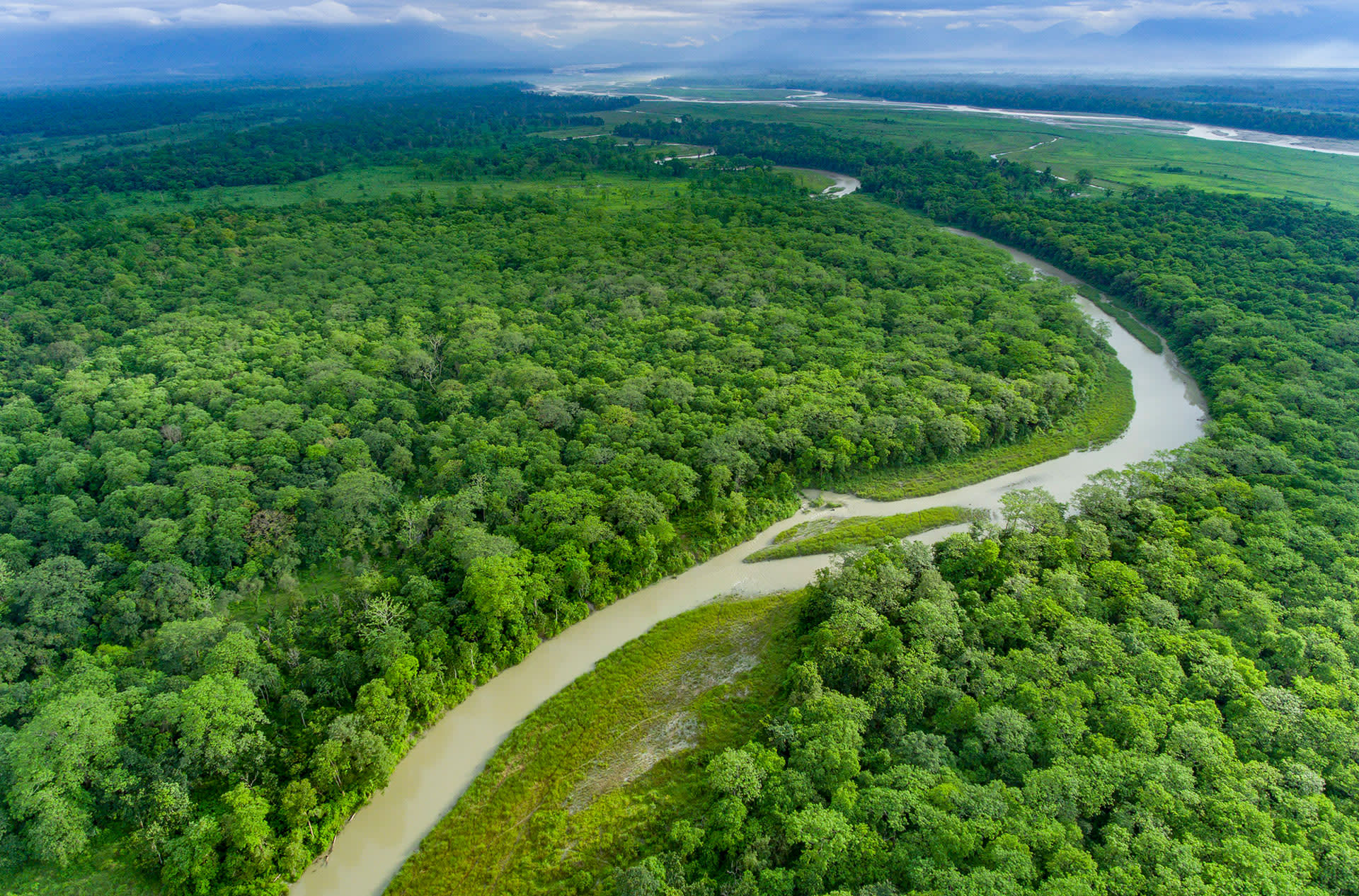 Listen to this article
•
15:34 min
Listen to this article
•
15:34 min
A six-foot-tall map of Jaldapara National Park captivated me as I stepped into the office of the Assistant Wildlife Warden at Madarihat in Alipurduar district of northern West Bengal. The national park is one among five situated in a narrow strip of the foothills of the Eastern Himalayas extending between Nepal and Bhutan. Flanked by tea gardens, this park is a mosaic of riverine, sal, wet mixed, semi-evergreen, evergreen, and savannah forests. The map’s spell over me broke when the warden Debdarshan Roy offered to drop me at my rest house within the park. An opportunity to spot the park’s wildlife at night was too good to turn down.
Refuge for megaherbivores
Jaldapara’s flagship species, the greater one-horned rhino, greeted us at close quarters on more than one occasion. These animals, geographically isolated due to fragmentation of their habitat over the years, are remnants of the erstwhile population inhabiting the Indo-Gangetic plains. Their presence prompted authorities to declare the area a game sanctuary in 1941. The game sanctuary was renotified as Jaldapara Wildlife Sanctuary in 1976, and subsequently, the wildlife sanctuary was upgraded to a national park in 2012.
Today, the 216-sq-km Jaldapara National Park is the second-largest habitat for rhinos in India and forms a vital gene pool reserve for the pachyderms outside Assam and Nepal. Rhino numbers in the park rebounded from a mere 14 in 1985 to 292 in 2022, owing to a slew of conservation measures taken over the years.
Cover photo: Distinguished by riverine forests and vast tracts of grasslands, a large part of the park lies in the floodplains of the Torsa River and other smaller rivers and rivulets.
A herd of elephants stood in our way at a bend of the Torsa River, which flows from north to south through the national park. Roy immediately reversed the vehicle at full throttle, and we were out of harm’s way before the herd could react. Much like the elephants we had just run into, the Torsa, too, is highly unpredictable. The river has changed its course multiple times over the past 150 years, leaving behind a network of dead streams with abandoned riverbeds.
Along with the rhino and elephant, the gaur, the world’s largest bovine, is the other megaherbivore which finds sustenance in the large tracts of grasslands along the Torsa’s floodplain. Gaur herds of 30-40 individuals awaited us the following day on a jeep safari from Madarihat to Hollong, a popular tourist route that lets you sight the park’s megafauna. Semul (Bombax ceiba), sida (Lagerstroemia parviflora) and jarul (Lagerstroemia speciosa) trees towered over the gaur grazing near the forest track. Despite guides telling them otherwise, most tourists referred to them as bison, a technically incorrect term for the bovid, which belongs to the genus Bos.
Indian rollers streaked past us, displaying their brilliant blue underparts as they flitted from one perch to another. The route lived up to its reputation, and we saw rhinos, elephants, and gaur feeding a few hundred metres from each other.

At the end of the safari, we went to Hollong Tourist Lodge, one of the most sought-after places to stay in Jaldapara. At a salt lick maintained by the forest department behind the lodge, rhinos, gaur, and sambar stood a few feet from each other. The forest department maintains similar salt licks (a mixture of black salt and molasses) near the Jaldapara, Kochubari, and Chilapata watchtowers to allow tourists to observe wildlife up close.
Dense woodlands
Jaldapara comprises nine territorial ranges: Jaldapara East, Jaldapara West, Jaldapara North, Jaldapara South, Chilapata, Kodalbasti, Madarihat, Nilpara, and Lankapara. Despite overcast skies the following day, I headed towards the denser forest ranges of Kodalbasti and Chilapata on the park’s eastern side. My guide read the disappointment on my face when it started raining a few minutes after our safari jeep left the Kodalbasti check post. He pointed to peacocks to raise my spirits and to apologise for the no-show by other fauna. I mostly overlooked their abundance, except when a brood of four chicks trailed their mother crossing the track.
Local legend states that Chilapata gets its name from Chila Rai, army general and younger brother of Maharaja Nara Narayan, the 16th-century king of Cooch Behar. Chila Rai’s swiftness on the battlefield was often compared to that of a chila (kite); he is believed to have taken refuge in these forests during his expeditions. We walked the last stretch towards the ruins of Nalraja Garh, a fort built during the Gupta period in the fifth century, circumventing a large tree sprawled across the track. The forest had entirely taken over the fort, once the capital of the ancient kingdom of Kamatapur.
I tagged along with Roy on his routine patrolling through the park the following afternoon. Driving along a ridge lined by sprawling tea gardens on one side and the Torsa on the other, he stopped for a moment so that I could get a closer look at a crested serpent eagle perched on a tree. We heard the distant honking of a flock of ruddy shelducks, which had stayed on the river beyond the winter.
Anthropogenic pressures
Conservation ecologist Aritra Kshettry, who works in this landscape, believes the historical change in land use has played a critical role in shaping human-animal conflicts in the region. “There was no concern about the habitat’s contiguity when the tea estates were established. Entire stretches of the forest got fragmented into small pieces such as Jaldapara and Gorumara,” he said.
Jaldapara National Park has about 53 villages and 12 tea gardens along its periphery. According to Kshettry, this is where most negative encounters with wildlife occur. “The quantum of damage caused by elephants is highest in the landscape, followed by leopards. Elephants cause loss of human life when there are accidental encounters; they destroy crops, houses, and buildings. Leopards are present in tea plantations in almost the entire north Bengal landscape. Since there are leopards in the landscape, there are interactions with people and human casualties as well,” he said.
Kshettry feels mitigation measures such as building energised fences around the park haven’t been effective. “Most of the elephants, especially males, move across protected areas in the landscape. A male in Buxa will travel to Jaldapara and then move to Gorumara. The fences did not work as the elephants often found a way to breach these barriers. They are now mostly driven from human habitations and crop fields to the nearest forest. An ex-gratia payment system has also been put in place, allowing affected individuals to be reimbursed for their losses,” he said.

Elephants and other animals move from the park’s north to the south, which has rich grasslands. However, the Alipurduar-Siliguri railway track and Siliguri-Guwahati national highway passing through the park impede their movement. “After some high-level meetings and engagement between conservationists, forest managers, and railway authorities, the number of elephant deaths has come down because the railways are following very strict speed limits inside the forest,” said Kshettry. He added that most elephant collision cases in the past five years or so have occurred outside the forest area, where there are no speed restrictions. He maintained that the highway, which was widened recently, continues to remain a threat to wildlife.
As I understood more about the topography and conservation issues of the landscape over the following days, the reason behind the peculiar shape of the park became clearer. But my aha moment truly arrived when I read what J Juan Spillet wrote in The Journal of Bombay Natural History Society in 1966. While the park’s total area has increased in the intervening years, his observation about its shape holds true even today: “The sanctuary proper includes 24,590 acres (38’42 square miles) and, with a little imagination, takes the form of a man’s pair of trousers. The northern boundary, or the ‘waist’, is approximately two and one-half miles across. The total length of the ‘legs’ is about 11 miles. And the length of the ‘inseams’ is almost eight miles.”














